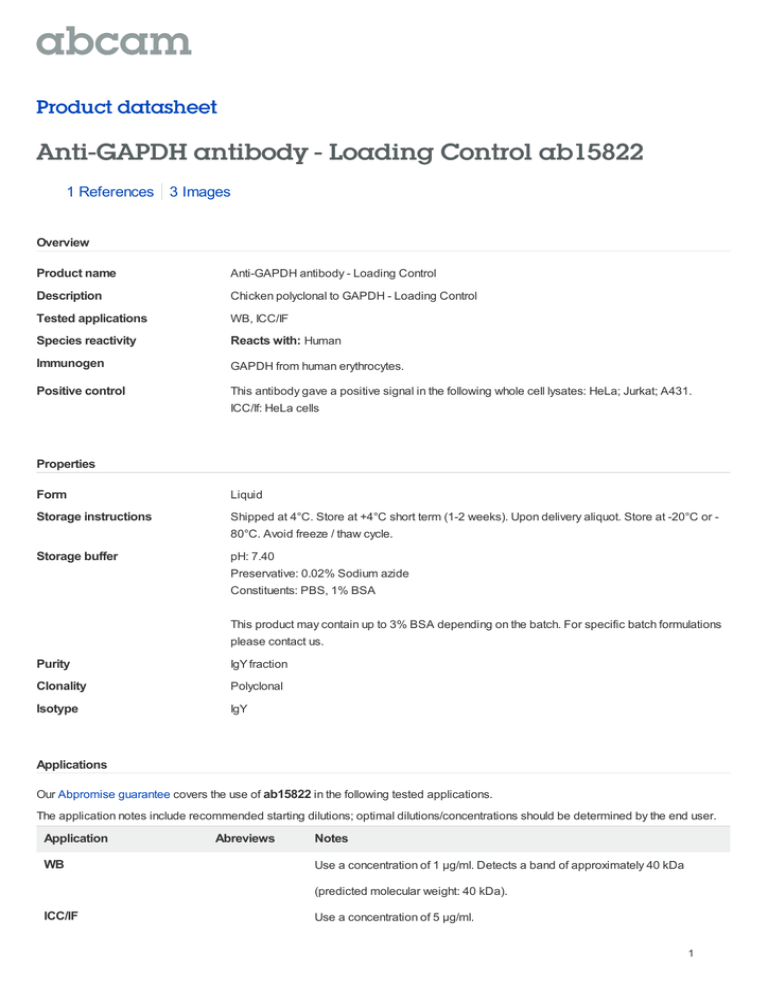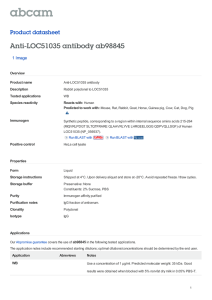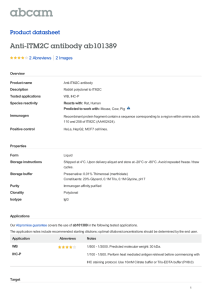Anti-GAPDH antibody - Loading Control ab15822 Product datasheet 1 References 3 Images
advertisement

Product datasheet Anti-GAPDH antibody - Loading Control ab15822 1 References 3 Images Overview Product name Anti-GAPDH antibody - Loading Control Description Chicken polyclonal to GAPDH - Loading Control Tested applications WB, ICC/IF Species reactivity Reacts with: Human Immunogen GAPDH from human erythrocytes. Positive control This antibody gave a positive signal in the following whole cell lysates: HeLa; Jurkat; A431. ICC/If: HeLa cells Properties Form Liquid Storage instructions Shipped at 4°C. Store at +4°C short term (1-2 weeks). Upon delivery aliquot. Store at -20°C or 80°C. Avoid freeze / thaw cycle. Storage buffer pH: 7.40 Preservative: 0.02% Sodium azide Constituents: PBS, 1% BSA This product may contain up to 3% BSA depending on the batch. For specific batch formulations please contact us. Purity IgY fraction Clonality Polyclonal Isotype IgY Applications Our Abpromise guarantee covers the use of ab15822 in the following tested applications. The application notes include recommended starting dilutions; optimal dilutions/concentrations should be determined by the end user. Application WB Abreviews Notes Use a concentration of 1 µg/ml. Detects a band of approximately 40 kDa (predicted molecular weight: 40 kDa). ICC/IF Use a concentration of 5 µg/ml. 1 Application Abreviews Notes IF Use a concentration of 5 µg/ml. Target Function Has both glyceraldehyde-3-phosphate dehydrogenase and nitrosylase activities, thereby playing a role in glycolysis and nuclear functions, respectively. Participates in nuclear events including transcription, RNA transport, DNA replication and apoptosis. Nuclear functions are probably due to the nitrosylase activity that mediates cysteine S-nitrosylation of nuclear target proteins such as SIRT1, HDAC2 and PRKDC (By similarity). Glyceraldehyde-3-phosphate dehydrogenase is a key enzyme in glycolysis that catalyzes the first step of the pathway by converting Dglyceraldehyde 3-phosphate (G3P) into 3-phospho-D-glyceroyl phosphate. Pathway Carbohydrate degradation; glycolysis; pyruvate from D-glyceraldehyde 3-phosphate: step 1/5. Sequence similarities Belongs to the glyceraldehyde-3-phosphate dehydrogenase family. Post-translational modifications S-nitrosylation of Cys-152 leads to interaction with SIAH1, followed by translocation to the nucleus. ISGylated. Cellular localization Cytoplasm > cytosol. Nucleus. Cytoplasm > perinuclear region. Membrane. Translocates to the nucleus following S-nitrosylation and interaction with SIAH1, which contains a nuclear localization signal (By similarity). Postnuclear and Perinuclear regions. Anti-GAPDH antibody - Loading Control images ab15822 staining GAPDH in HeLa cells. The cells were fixed with 100% methanol (5min) and then blocked in 1% BSA/10% normal goat serum/0.3M glycine in 0.1%PBS-Tween for 1h. The cells were then incubated with ab15822 at 5μg/ml and ab7291 at 1µg/ml overnight at +4°C, followed by a further incubation at room temperature for 1h with an AlexaFluor®488 Goat anti-Chicken secondary (ab150173) at 2 μg/ml (shown in green) and AlexaFluor®594 Goat anti-Mouse Immunofluorescence - Anti-GAPDH antibody - secondary (ab150120) at 2 μg/ml (shown in Loading Control (ab15822) pseudo color red). Nuclear DNA was labelled in blue with DAPI. Negative controls: 1– Rabbit primary antibody and anti-mouse secondary antibody; 2 – Mouse primary antibody and anti-rabbit secondary antibody. Controls 1 and 2 indicate that there is no unspecific reaction between primary and secondary antibodies used. 2 Anti-GAPDH antibody - Loading Control (ab15822) at 1 µg/ml + HeLa whole cell lysate at 20 µg Secondary Goat Anti-Chicken IgG (H&L) secondary at 1/10000 dilution Performed under reducing conditions. Predicted band size : 40 kDa Western blot - GAPDH antibody (ab15822) ab15822 detects a band of ~ 40 kDa in HeLa, Jurkat and A431 whole cell lysates. ICC/IF image of ab15822 stained human MCF7 cells. The cells were methanol fixed (5 min), permabilised in 0.1% PBS-Tween (20 min) and incubated with the antibody (ab15822, 5µg/ml) for 1h at room temperature. 1%BSA / 10% normal goat serum / 0.3M glycine was used to block nonspecific protein-protein interactions. The Immunocytochemistry/ Immunofluorescence - secondary antibody (green) was Alexa Fluor® GAPDH antibody (ab15822) 488 goat anti-chicken IgG (H+L) used at a 1/1000 dilution for 1h. Alexa Fluor® 594 WGA was used to label plasma membranes (red). DAPI was used to stain the cell nuclei (blue). This antibody also gave a positive IF result in HeLa, HEK 293 and HepG2 cells. Please note: All products are "FOR RESEARCH USE ONLY AND ARE NOT INTENDED FOR DIAGNOSTIC OR THERAPEUTIC USE" Our Abpromise to you: Quality guaranteed and expert technical support Replacement or refund for products not performing as stated on the datasheet Valid for 12 months from date of delivery Response to your inquiry within 24 hours We provide support in Chinese, English, French, German, Japanese and Spanish Extensive multi-media technical resources to help you We investigate all quality concerns to ensure our products perform to the highest standards If the product does not perform as described on this datasheet, we will offer a refund or replacement. For full details of the Abpromise, please visit http://www.abcam.com/abpromise or contact our technical team. 3 Terms and conditions Guarantee only valid for products bought direct from Abcam or one of our authorized distributors 4


